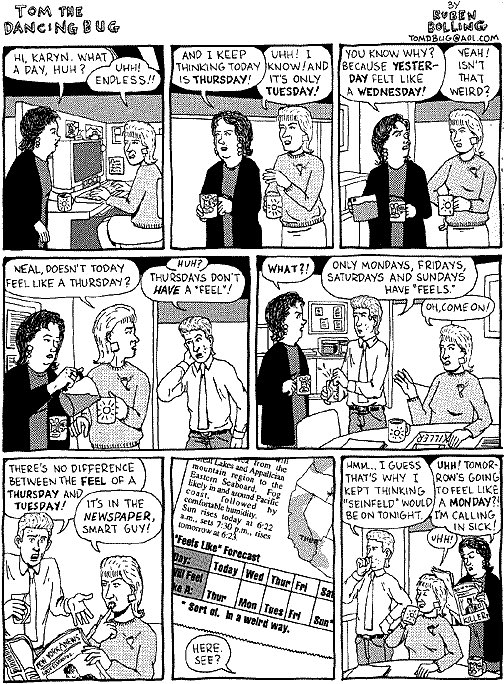Every now and again, the “Feels Like” Forecast bubbles into my consciousness—via a tweet from someone with a long memory, say, or a time-shifted reference to the day of the week not seeming right, or when a pandemic reduces our collective view of the calendar to mush. It came up again this week, so I thought I’d tell the tale of my one moment of viral internet glory, way back in the twentieth century.
The forecast dates to the era of Yahoo, back when search was useful but not ubiquitous. Yahoo was a success because it catalogued the web, back when it was somewhat feasible to do so. Early netizens saw Yahoo’s well-organized directory of links as a tool and a note of validity, which made Yahoo something of an arbiter of taste; they also had “New” and “Cool” GIF slugs that website owners craved.
In its attempts to be comprehensive, Yahoo didn’t just organize obvious links, like news and sports; they also had fun subcategories for the humor, games and fun that populated much of the early, homemade Internet (capital “i”). One of the pages I frequented was Cool Links, a regularly updated list of entertaining destinations.
At the time, there were a few online zines that were must-reads, including Slate and Salon. The latter carried some comics, including Tom the Dancing Bug, a strip I’d been reading since college. One week in 1997, this appeared:

I thought that was a stroke of genius, and I also thought to myself, That would make for a funny website.
Now, in 1997, web programming was simple and quick; I was building pages daily for work and play. So I whipped up a real-world version of the Tom the Dancing Bug “forecast,” complete with my own predictions (e.g. long weekend? Two Saturdays, no Tuesday). I promised myself I’d update the page a few times a week, and posted it live.
In the pre-social-media era, there were two ways to get the word out: personal website cross-linking and search engines. I posted it on my site and got folks to link back to it, which started to generate traffic. I also submitted the site to Yahoo. And sure enough, they put it on their Cool Links page, complete with ![]() gif. (I don’t know that it ever achieved “cool” status, but for the record, those listings got shades:
gif. (I don’t know that it ever achieved “cool” status, but for the record, those listings got shades: ![]() )
)
Yahoo’s site used to showcase new links at the top of the page, and when the Forecast appeared, the floodgates opened. Traffic spiked by a few thousand percent. My site host warned me of an unwieldy surge in daily data transfer. Most amusingly to me, an early ad network called ValueClick invited me to add their banners, and I said sure, why not, and got a check for $127 a few months later. The spike was quick but oh so satisfying.
I kept the site up to date for nearly six years. At one point, my friend David Miller and I pulled together a PHP database and rendering engine, so I could set the forecast weeks in advance, rather than updating the HTML by hand every morning. We also put in a visitor poll. But the site was past peak, and the poll never got more than a few dozen votes, and my ad revenue slowly dwindled to zero.
A few years later, my site host updated their servers and broke our primitive PHP, so we installed a new script that keeps the dates current. That’s the last the site was touched. Around 2009, some coworkers and I relaunched the concept as a Facebook app, but it broke before we built up an audience, and the developers quickly lost interest. Not much has happened of consequence since. The Forecast had all of 327 page views in the 90 days leading up to this post.
But! I am still proud of the “Feels Like” Forecast, for a few reasons, all of them deeply personal.
- I built a thing, amused myself, and then amused others with it.
- I managed to create and ride a wave of viral popularity, however early and brief.
- The site’s HTML is pristine. Look at it! The page renders perfectly and it’s 24 years old. No linkrot here, either.
- And hey, I made a few bucks. (Very few, but hey!) Those ValueClick ad scripts are still in the page source. Maybe I should turn them back on.